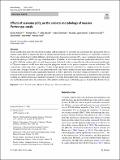Files in this item
Effects of seawater pCO2 on the skeletal morphology of massive Porites spp. corals
Item metadata
| dc.contributor.author | Allison, Nicola | |
| dc.contributor.author | Ross, Phoebe | |
| dc.contributor.author | Brasier, Alex | |
| dc.contributor.author | Cieminska, Nadia | |
| dc.contributor.author | Lopez Martin, Nicolas | |
| dc.contributor.author | Cole, Catherine | |
| dc.contributor.author | Hintz, Chris | |
| dc.contributor.author | Hintz, Ken | |
| dc.contributor.author | Finch, Adrian Anthony | |
| dc.date.accessioned | 2022-05-10T13:30:17Z | |
| dc.date.available | 2022-05-10T13:30:17Z | |
| dc.date.issued | 2022-05-10 | |
| dc.identifier | 278847314 | |
| dc.identifier | d50ac471-eba4-4770-a94e-1b6339eb4311 | |
| dc.identifier | 000793201100003 | |
| dc.identifier | 85130010489 | |
| dc.identifier.citation | Allison , N , Ross , P , Brasier , A , Cieminska , N , Lopez Martin , N , Cole , C , Hintz , C , Hintz , K & Finch , A A 2022 , ' Effects of seawater pCO 2 on the skeletal morphology of massive Porites spp. corals ' , Marine Biology , vol. 169 , 73 . https://doi.org/10.1007/s00227-022-04060-9 | en |
| dc.identifier.issn | 0025-3162 | |
| dc.identifier.other | ORCID: /0000-0002-3689-1517/work/113060853 | |
| dc.identifier.other | ORCID: /0000-0003-3720-1917/work/113060960 | |
| dc.identifier.uri | https://hdl.handle.net/10023/25337 | |
| dc.description | This work was supported by the UK Natural Environment Research Council (award NE/I022973/1) to AAF and NA. | en |
| dc.description.abstract | Ocean acidification alters the dissolved inorganic carbon chemistry of seawater and can reduce the calcification rates of tropical corals. Here we explore the effect of altering seawater pCO2 on the skeletal morphology of 4 genotypes of massive Porites spp which display widely different calcification rates. Increasing seawater pCO2 causes significant changes in in the skeletal morphology of all Porites spp. studied regardless of whether or not calcification was significantly affected by seawater pCO2. Both the median calyx size and the proportion of skeletal surface occupied by the calices decreased significantly at 750 µatm compared to 400 µatm indicating that polyp size shrinks in this genus in response to ocean acidification. The coenosteum, connecting calices, expands to occupy a larger proportion of the coral surface to compensate for this decrease in calyx area. At high seawater pCO2 the spines deposited at the skeletal surface became more numerous and the trabeculae (vertical skeletal pillars) became significantly thinner in 2 of the 4 genotypes. The effect of high seawater pCO2 is most pronounced in the fastest growing coral and the regular placement of trabeculae and synapticulae is disturbed in this genotype resulting in a skeleton that is more randomly organised. The study demonstrates that ocean acidification decreases the polyp size and fundamentally alters the architecture of the skeleton in this major reef building species in the Indo-Pacific Ocean. | |
| dc.format.extent | 11 | |
| dc.format.extent | 4585825 | |
| dc.language.iso | eng | |
| dc.relation.ispartof | Marine Biology | en |
| dc.subject | Coral | en |
| dc.subject | Ocean acidification | en |
| dc.subject | Polyp size | en |
| dc.subject | Calcification | en |
| dc.subject | Skeleton | en |
| dc.subject | GC Oceanography | en |
| dc.subject | DAS | en |
| dc.subject | SDG 14 - Life Below Water | en |
| dc.subject.lcc | GC | en |
| dc.title | Effects of seawater pCO2 on the skeletal morphology of massive Porites spp. corals | en |
| dc.type | Journal article | en |
| dc.contributor.sponsor | NERC | en |
| dc.contributor.institution | University of St Andrews. School of Earth & Environmental Sciences | en |
| dc.contributor.institution | University of St Andrews. Marine Alliance for Science & Technology Scotland | en |
| dc.contributor.institution | University of St Andrews. Scottish Oceans Institute | en |
| dc.contributor.institution | University of St Andrews. St Andrews Isotope Geochemistry | en |
| dc.contributor.institution | University of St Andrews. Centre for Energy Ethics | en |
| dc.identifier.doi | 10.1007/s00227-022-04060-9 | |
| dc.description.status | Peer reviewed | en |
| dc.identifier.grantnumber | NE/I022973/1 | en |
This item appears in the following Collection(s)
Items in the St Andrews Research Repository are protected by copyright, with all rights reserved, unless otherwise indicated.

